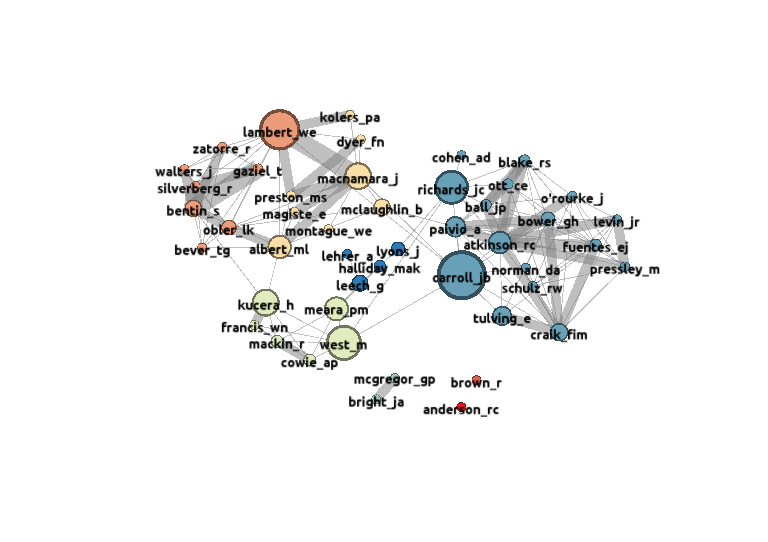| |
 |
|
| |
|
|
|
Lognostics Maps 1982
|
|
lognostics maps
VARGA
lognostics home
|

|
|
data source: VARGA 1982: data analysis July 2011
data: 37 papers, 47 nodes, 144 co-citations, 5+3 clusters
threshold for inclusion: Authors must be cited in at least three different papers. Co-citations occurring less than twice are excluded.
47 authors are cited in at least three papers in the 1982 data. This number is considerably smaller than we would normally use for a co-citation analysis, but it accurately reflects the amount of work that was being carried out at the time.
Points to note in this map are the following:
The map identifies eight clusters in the 1982 data. Three of the clusters are disconnected from the main clusters, and two of them consist of only a single member. These nodes represent people who are frequently cited, but not consistently cited alongside the same people.
Broadly speaking, the number of links between authors is very low.
Strikingly, most of the names in this map will probably be unfamiliar to vocabulary researchers. The nodes in this map are sized by their "betweenness centrality". This measure gives prominence to people who act as important links between a number of research clusters. In this map, these central figures are: Carroll, Lambert, West, Richards, Kucera, Macnamara, Meara, Albert, Atkinson and Paivio.
Apart from West, Richards and Meara, none of these figures continue to play this role in later years.
The main clusters identified in this map are as follows:
Cluster I, focussed around Lambert, is mainly concerned with the psycholinguistic implications and effects of bilingualism. Lambert works with French/English bilinguals; other people in this group work on other languages, notably Hebrew.
This group includes Lambert, Zatorre, Walters, Silverberg, Bentin, Gaziel, Obler and Bever.
Cluster II, focussed on Macnamara is largely populated by social and educational psychologists. It deals principally with aspects of bilingual performance, but also includes people working on the neurolinguistics of bilingualism. Members of this group include: Macnamara, Kolers, Dyer, Preston, Magiste, McLaughlin, and Montague.
Cluster III, dominated by Carroll, is the largest cluster in the map, mainly composed of psychologists who work on imagery and memory. The cluster includes Blake, Ott, Ball, Paivio, Atkinson, Bower, Norman, Schultz, Tulving, Craik, Pressley, Levin, O'Rourke and Fuentes, and Richards, Carroll and Paivio. This group seems to form the main L2 vocabulary cluster. Imagery mnemomics are represented by Blake and Ott, while Pressley, Levin, O'Rourke and Fuentes form a sub-group that works on the keyword mnemonic system.
Cluster IV, dominated by Kucera and West, seems to be a cluster whose main focus is word frequency and its implications.
Cluster V, the small group in the centre of the map, consisting of Halliday, Leech, Lehrer and Lyons is a group of people working on semantic theory.
The main structural feature worth noting in this map is the relatively dense connections within Cluster I and II and within Cluster III. The other links in this map, particularly the links between the main clusters, are very weak. Carroll and Richards play a critical role in linking the main clusters together.
|

